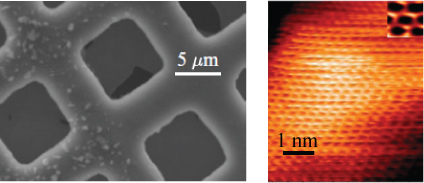New Method Offers Control of Strain on Graphene Membranes

Left, an atomic force microscope image of the suspended graphene membrane on the copper mesh. On the right, a scanning tunneling microscope image with atomic resolution taken on the suspended graphene membrane. The researchers were able to use the scanning tunneling microscope to control the shape, and therefore the electronic properties, of the graphene membrane. Courtesy image.
FAYETTEVILLE, Ark. – Graphene could be the superhero of materials – it’s light, strong and conducts heat and electricity effectively, which makes it a great material for potential use in all kinds of electronics. And because it’s made from carbon atoms, graphene is cheap and plentiful. Its electric and mechanical properties also affect one another in unique ways. But before freestanding graphene can live up to its potential, scientists need to be able to control these properties.
A group of physicists from the University of Arkansas and other institutions have developed a technique that allows them to control the mechanical property, or strain, on freestanding graphene, sheets of carbon one-atom thick suspended over the tops of tiny squares of copper. By controlling the strain on freestanding graphene, they also can control other properties of this important material.
“If you subject graphene to strain, you change its electronic properties,” said physics professor Salvador Barraza-Lopez. Strain on freestanding graphene causes the material to behave as if it is in a magnetic field, even though no magnets are present, a property that scientists will want to exploit -- if they can control the mechanical strain.
To control the mechanical strain, University of Arkansas researchers developed a new experimental approach. Physicists Peng Xu, Paul Thibado and students in Thibado’s group examined freestanding graphene membranes stretched over thin square “crucibles,” or meshes, of copper. They performed scanning tunneling microscopy with a constant current to study the surface of the graphene membranes. This type of microscopy uses a small electron beam to create a contour map of the surface. To keep the current constant, researchers change the voltage as the scanning tunneling microscope tip moves up and down, and the researchers found that this causes the freestanding graphene membrane to change shape.
“The membrane is trying to touch the tip,” Barraza-Lopez said. They discovered that the electric charge between the tip and the membrane influences the position and shape of the membrane. So by changing the tip voltage, the scientists controlled the strain on the membrane. This control becomes important for controlling the pseudo-magnetic properties of graphene.
In conjunction with the experiments, Barraza-Lopez, Yurong Yang of the University of Arkansas and Nanjing University, and Laurent Bellaiche of the University of Arkansas examined theoretical systems involving graphene membranes to better understand this new-found ability to control the strain created by the new technique. They verified the amount of strain on these theoretical systems and simulated the location of the scanning tunneling microscopy tip in relation to the membrane. While doing so, they discovered that the interaction of the membrane and tip depends upon the tip’s location on the freestanding graphene. This allows scientists to calculate the pseudo-magnetic field for a given voltage and strain.
“If you know the strain, you can use theory and compute how big the pseudo-magnetic field may be,” said Barraza-Lopez. They found that because of the boundaries created by the square copper crucible, the pseudo-magnetic field swings back and forth between positive and negative values, so scientists are reporting the maximum value for the field instead of a constant value.
“If you were able to make the crucibles triangular, you would be closer to having non-oscillating fields,” Barraza-Lopez said. “This would bring us closer to using this pseudo-magnetic property of graphene membranes in a controlled way.”
The researchers report their findings in Physical Review B Rapid Communications.
Full details of this work are available online (PRB 85, 121406(R) (2012)). Scientists involved in the research are from the University of Arkansas, Nanjing University, École Centrale Paris, Quingdao University and Missouri State University.
Contacts
Salvador Barraza-Lopez, professor of physics
J. William Fulbright College of Arts and Sciences
479-575-5933, sbarraza@uark.edu
Melissa Blouin, director of science and research communication
University Relations
479-575-3033,
blouin@uark.edu